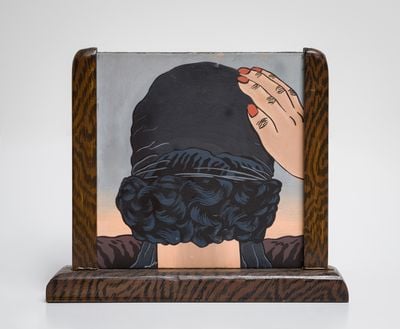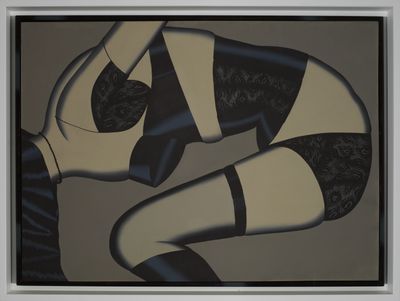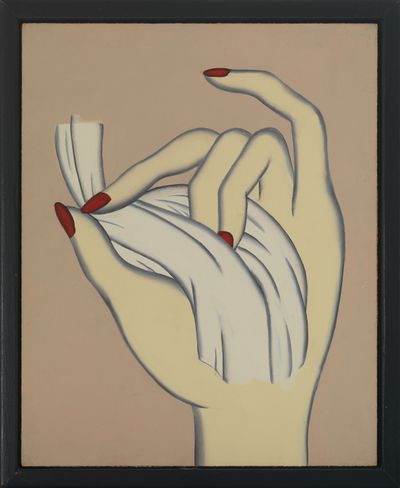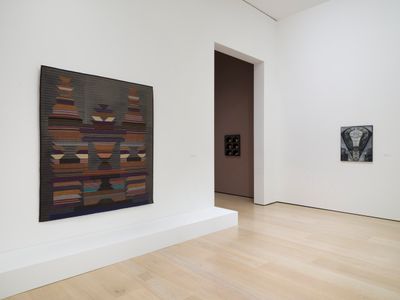
06 Nov Christina Ramberg’s Bodily Transmissions
Source Credit: Content and images from Ocula Magazine. Read the original article - https://ocula.com/magazine/features/christina-rambergs-bodily-transmissions/
Christina Ramberg was undoubtedly one of the most unique American painters to have emerged in the second half of the 20th century, as her first retrospective in some 30 years affirms.
Organised by the Art Institute of Chicago, and currently on view at the Hammer Museum in Los Angeles through 5 January 2025, Christina Ramberg: A Retrospective is an impressive insight into the artist’s inimitable aesthetic. A total of 78 paintings, 12 works on paper, six bound volumes, and five quilts track Ramberg’s career, from her time as a student at the School of Art Institute Chicago (SAIC) through to her untimely death in 1995 at the age of 49.
Born in 1946, Ramberg enrolled at SAIC in 1964, graduating with a degree in painting and printmaking in 1968, by which time her characteristic comic-book style was fully formed.
A 1968 series of acrylic-on-Masonite portraits in muted earth tones attests to the distinctive language that Ramberg honed. Installed on the backs of table-top mirrors, the frames of which the artist painted to create artificial wood grains, each panel shows a woman’s head viewed from the back, with a single hand patting their stylised hair. As with Cabbage Head (1968), where a hand caresses the straightened half of a curly blonde head.
Christina Ramberg, Untitled (Hair) (1968). Acrylic on Masonite, in artist’s hand painted wood frame. 17.8 x 51.5 cm. Courtesy Joel Wachs.
Hair (1968) maximises this compositional gesture. Sixteen panels, laid flat on a custom frame to form a four-by-four grid, show variations of the same pose—a woman viewed from the back with differing hairstyles and hand placements—against an olive-green ground that shifts to a luminous, radioactive lime around each subject. (When Ramberg first showed the work, she invited gallery-goers to change the order of the images.)
After seeing Hair, fellow artist Jim Nutt mentioned Ramberg to Don Baum, then director of Chicago’s Hyde Park Art Center, leading to exhibitions at the space by the False Image group—comprising Ramberg and SAIC classmates Roger Brown, Eleanor Dube, and Philip Hanson—in 1968 and 1969. ‘We are interested in the effects gained by withholding information in a work,’ Ramberg told the Chicago Daily News at the time.
Christina Ramberg, Belle Rêve (1969). Acrylic in Masonite, in artist’s hand painted wood frame. 29.3 xx 88.3 cm. Collection of Michael J Robertson and Christopher A Slapak.
Ramberg’s painting was all about withholding—a tension that speaks to the artist’s enduring fixation with the body and its contortions, whether medical or sexual. Take her 1969 portraits of women in profile, their rash-covered faces obscured by a hand. Or triptychs deconstructing the female form into a sequence of clothes and accessories, as with Belle Rêve (1969), which lines up square panels of a black-lace corset, black high-heeled shoes, and black-hat covered auburn hair caressed by a black-gloved hand.
Ramberg repeated the deconstruction of the female form in 1972 for the first of many commissions for Playboy. Across four frames, a hand touches the tip of a ponytail whose shape recalls a flaccid penis; a torso in a bustier is viewed from the side; a woman in panties and pull-ups is cut off at the head and thigh; and a plump foot fills a single black high heel.
Christina Ramberg, Waiting Lady (1972). Acrylic on hardboard. 57.8 × 82 cm. Anstiss and Ronald Krueck Collection. Photo: Jamie Stukenberg.
Speaking to her interest in BDSM—as evidenced in a collection of print ephemera that includes the personal ads magazine Aggressive Gals—Waiting Lady (1972), painted the year Ramberg attained her MFA from SAIC, is a large acrylic on Masonite that shows a woman wearing black lace and satin lingerie. Bent over, the woman’s face is shrouded by her long black hair while her arms reach beyond the frame as if they are tied behind her back. Ramberg explained the title in her diary: ‘She appears to either be waiting on someone or waiting obediently to have something done to her.’
Defined by thin layers of paint, sanded-out brushstrokes, and matte surfaces, the details in Ramberg’s paintings are what makes them so striking. Feather-fine lines are cross-hatched with a masterful lightness to create the effect of lace and mesh; by contrast, bold chrome gradations amplify the sheen and tactility of satin and silk.
Exhibition view: Christina Ramberg: A Retrospective, Hammer Museum, Los Angeles (12 October 2024–5 January 2025). Photo: Jeff McLane.
When it comes to hair, a recurring theme in her repertoire, Ramberg’s comic-book lines appear almost Byzantine in their precise iconography. Among her many scrapbooks on view in Christina Ramberg: A Retrospective, Untitled (Comic Book Scrapbook I) (1964–67) is opened at a page filled with cuttings of hairstyles from comic illustrations and wig advertisements, illuminating the indexical precision with which Ramberg pursued her subject.
That indexicality comes through in Corsets/Urns (1970), painted while Ramberg was a graduate student at SAIC. Eight acrylic-on-Masonite panels arranged in a line show varying forms of corsets fused with urns rendered in a striking pattern approximating auburn hair.
Christina Ramberg, Hand (#2) (1971). Acrylic on Masonite. 23.9 x 18.8 cm. Private collection, New York.
Hands, too, feature heavily in her sketchbooks, including those Ramberg developed while on a trip to Europe in 1970, where she encountered erotic prints by the 18th century Japanese woodblock artist Kitagawa Utamaro and focused on sketching the hands in them. That encounter led to three square panels, Untitled (Hand) (1971), showing a delicate, peach-hued hand holding a white cloth against a taupe ground, and a larger square depicting a hand with fingers teasingly strapped down by a black, hair-like ribbon, aptly titled Bound Hand (1973).
Ramberg’s painting was all about withholding—a tension that speaks to the artist’s enduring fixation with the body and its contortions, whether medical or sexual.
Around that time, the artist also created a series of panels showing a headless woman from behind, with a single hand fingering a garment—in the case of Probed Cinch (1971), a corset—or locks of hair dropping into the frame. Returning the male gaze with a coquettish yet commanding wink, these works are full of charisma and wit. Ramberg amplified that command in a series of totemic forms that echo the shape of a sleeve and/or an erect phallus, as suggested in titles like Tall Tickler (1974), referencing a style of French condom.
Christina Ramberg, Probed Cinch (1971). Acrylic on Masonite, in artist’s hand painted wood frame. 30.5 x 30.5 cm. Private collection, New York.
Then, in October 1973, tragedy struck. Ramberg lost the baby she delivered prematurely, and the lightness with which she treated the female form gave way to a more estranged interaction with the body as a site of damage and repair.
Though rendered in strokes recalling the mesh and hair defining Ramberg’s previous forms, large panels like Troubled Sleeve and Istrian River Lady (both 1974) show half a headless body in profile wrapped in medical bandages, braces, and splints. While Gloved, also from 1974, shows a full-frontal body cut off at the head and lower thighs. Although dressed in a black bra and shapewear, the figure’s flesh has given way to white gauze-covered contours executed with fine black lines, with lower arms and hands replaced by black, hair-gloved stumps.
This deconstruction continued over the next few years, with full-frontal depictions that treated the body as a formal grid rendering the figure alien and incomplete. In Broken (1975), for instance, a front-facing headless and fleshless figure has been built out of steel frames wrapped in black and orange fabrics.
Defined by thin layers of paint, sanded-out brushstrokes, and matte surfaces, the details in Ramberg’s paintings are what makes them so striking.
Paintings of the body continued to evolve into structural interrogations. Hereditary Uncertainty (1977), for example, shows a figure split down the middle, with one side depicted as a brown frame, and the other filled out with flesh and covered in a stylised white cotton collar and skirt.
Marking a shift towards asymmetry, Ramberg called these compositions ‘split personalities’—a reflection of her view that ‘our souls are not symmetrical.’ That asymmetry expands in paintings from the early 1980s, in which figures dressed in men’s and women’s clothing possess both male and female attributes, in a colour palette that diverges from her characteristically muted hues. In Simultaneous Emergence (1981), a body constructed from thick blocks and textured shapes centres two figures mirroring each other in a handstand against a bright blue ground, seemingly about to emerge from the womb.
The seriality that defined Ramberg’s practice, which echoed the frame-by-frame format of the comic strip, naturally resonated with the work of Bernd and Hilla Becher, whose photographic indexes of water towers spoke to Ramberg so much that she recalled feeling like they were hers when she encountered them in the late 1970s.1
Christina Ramberg, O.H.#2 (1976). Acrylic on Masonite in artist’s frame. 90.2 x 78.8 cm. Illinois State Museum, Illinois Legacy Collection.
The 1976 series ‘O.H.’, short for ‘Origami Hat’, seems to draw on the Bechers’ influence, with steel-grey geometric forms, based on Japanese paper-folding, rendered on sienna grounds. Four such shapes are arranged in a two-by-two grid in O.H. #1 and O.H. #2, recalling the Bechers’ architectural taxonomies. Another group of untitled paintings from the early 1980s, which recall the artist’s earlier Corsets/Urns, speaks to this move to structure. The torso is completely abstracted, its shape infilled with linear and cross-hatched patterns that refer to garments the artist described, among other terms, as ‘aprons’ and ‘futuristic space-suits’.
Marking a shift towards asymmetry, Ramberg called these compositions ‘split personalities’—a reflection of her view that ‘our souls are not symmetrical.’
Though Ramberg turned away from painting in 1983, the influence of her late torso works is palpable in the quilts she created thereafter, as she incorporated a long-standing hobby into her artistic repertoire. Japanese Showcase (1984), for instance—made from striped kimonos bought from a temple flea market in Kyoto—is a five-by-four grid of units uniformly composed of striped squares mounted on four black diamonds (forming an ‘x’) atop another striped square, in muted tones ranging from burnt orange to taupe.
This play on pattern continued in the artist’s final six quilts, titled using roman numerals, in which she applied shapes onto fabric to compose totemic forms. These works were created between 1987 and 1989—one year before the artist was diagnosed with the rare neurodegenerative disease that would claim her life.
Exhibition view: Christina Ramberg: A Retrospective, Hammer Museum, Los Angeles (12 October 2024–5 January 2025). Photo: Jeff McLane.
Just four years before her diagnosis, Ramberg was appointed first female chair of the painting and drawing department at SAIC, having begun her career there as a part-time member of the teaching staff. By then, she had cemented her place in Chicago’s art scene as an artist’s artist, having built a strikingly coherent body of work that, as Christina Ramberg: A Retrospective demonstrates, has stood the test of time.
While marking a significant break from her earlier style, Ramberg’s final untitled paintings from 1986 resonate with both her totemic quilts and her works from the mid-1970s. Satellite shapes rendered in white lines on black- and grey-scale grounds seem to invoke the movement of signals emanating from spaceships, satellites, and antennae.
Admittedly, these compositions feel like an anomaly within her broader practice. But perhaps they also represent the final testimonies of an artist contemplating the fact that the image becomes the transmission after the body is gone. That Ramberg’s work continues to speak to the present is a testament to that contemplation. —[O]
1 Thea Liberty Nicholls, ‘Parallel Manipulations: Christina Ramberg’s Art and Archive, p29 exhibition catalogue for Christina Ramberg: A Retrospective.
Source Credit: Content and images from Ocula Magazine. Read the original article - https://ocula.com/magazine/features/christina-rambergs-bodily-transmissions/








